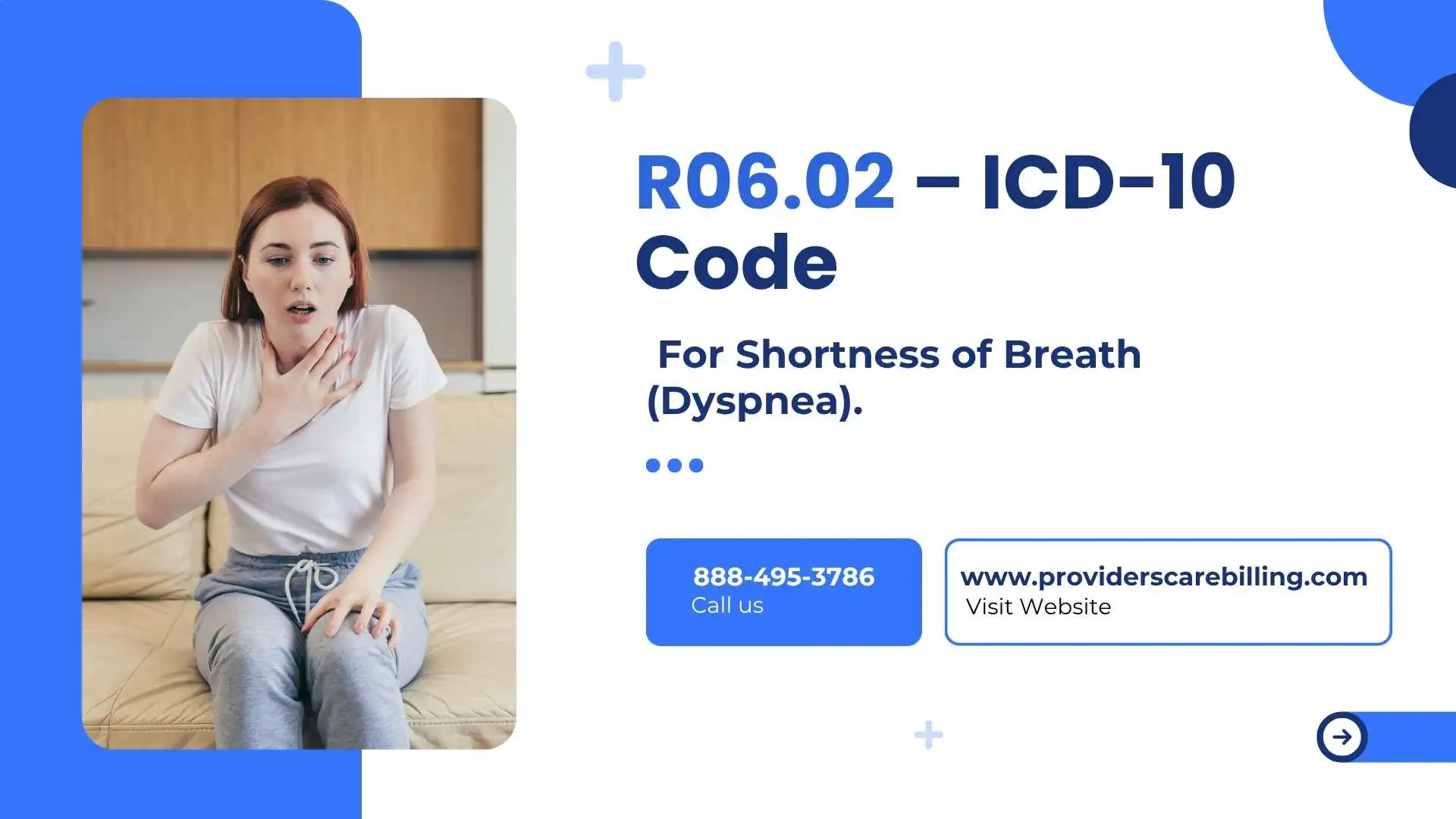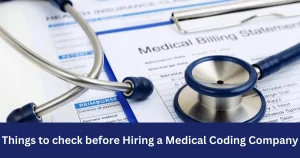ICD-10 code for SOB is often used for the diagnosis of Shortness of breath. It is mainly used when a patient reports difficulty in breathing but isn’t diagnosed with any significant clinical diseases.
For Example…
Asthma, Heart Conditions, Respiratory Infections, or Anxiety.
R06.02 is the most commonly used ICD-10 Code. It is a part of the ICD-10-CM coding system and helps to diagnose instances like dyspnea. In this blog, we’ll talk about what SOB is, its clinical terms, and ICD codes used in its diagnosis.
What is Shortness of breath (SOB)?
Dyspnea or shortness of breath is a common symptom that describes the feeling of not getting enough air to breathe properly. It can be sudden or gradual, and can be mildly uncomfortable for a lot of patients. Shortness of breath ICD-10 is usually coded as R06.02 in clinical documentation, which allows medical workers to track all necessary progress.
For Example, if someone feels short of breath during physical exertion, like climbing stairs or exercising, then it might be Dyspnea. But if someone reports difficulty in breathing even while at rest, then it may be something a lot more serious, such as heart failure, asthma, or even some pulmonary disease.
ICD-10 Code for SOB (R06.02) – When and How to Use it
The ICD-10 code of SOB (shortness of breath) is R06.02. It is used to code symptoms like dyspnea and other respiratory discomfort. This code is only used if a patient has SOB without any other diagnosis of a significant clinical disease.
R06.02 covers a range of respiratory complaints, including:
- Dyspnea on exertion
- Air hunger
- Breathlessness
These are the terms that can be used in medical records and consultation documents, if a patient complains of symptoms like “I can’t catch my breath”
When is R06.02 Used?
This code is commonly used if there is a concern of SOB, but not yet tied to a confirmed condition. Examples include:
- Exertional dyspnea due to physical activity
- COVID-19 Respiratory Symptoms Before Test Confirmation
- Early Stages of Congestive Heart Failure (CHF)
- General Shortness of Breath Evaluation in Outpatient or ER Settings
When Not to Use R06.02
It is worth learning that R06.02 is not to be used in case a more definite diagnosis is present. Excludes 1 note in ICD-10 coding rules. This code is not used when the shortness of breath is already due to:
- Chronic Obstructive Pulmonary Disease (COPD)
- Asthma
- pulmonary embolism (PE)
- Pneumonia, etc.
In such cases, the main condition should be coded rather than the symptom..
The appropriate code will assist in proper documentation, facilitate proper billing, and enhance clinical communication. The ICD-10 code SOB classification, such as R06.02, may appear easy to understand, but it is critical in both normal and emergency cases.
SOB-Related Codes (R06 Series)
Here are some codes that can be used to document dyspnea or SOB:
| ICD-10 Code | Description |
| R06.00 | Dyspnea, unspecified |
| R06.01 | Orthopnea |
| R06.02 | Shortness of breath on exertion |
| R06.03 | Acute respiratory distress |
| R06.09 | Other forms of dyspnea |
| R06.2 | Wheezing |
| R06.4 | Hyperventilation |
| R06.6 | Hiccough |
| R06.89 | Other abnormalities of breathing |
| R06.9 | Unspecified abnormalities of breathing |
Other Related Codes (Based on Cause of SOB)
If the reason is known, I mean “What Caused the SOB”, then their codes can be used for more accurate documentation.
- J44.1 – COPD with (acute) exacerbation
- I50.9 – Heart failure, unspecified (often associated with SOB in CHF cases)
- J45.901 – Unspecified asthma with (acute) exacerbation
- J80 – Acute respiratory distress syndrome (ARDS)
- U07.1 – COVID-19 (if confirmed and causing respiratory symptoms)
How to Document SOB (Shortness of Breath) Accurately?
Did you know that ICD-10 SOB is among the Top 10 most commonly used ICD-Codes in medical billing?
So, it is vital to document SOB accurately, and here are some tips that will help you do that…
Keep Proper Notes
Always include both the symptoms and any related conditions. For example:
“Patient reports shortness of breath on exertion with mild wheezing. History of asthma.”
This level of detail supports coding R06.02 for exertional SOB while also allowing linkage to a primary diagnosis if applicable (like asthma or COPD).
Exertional vs. Non-Exertional SOB
- ICD-10 R06.02 – Use for shortness of breath on exertion only.
- ICD-10 R06.00 – Use when the shortness of breath is non-specific or there’s not enough detail provided.
Avoid using R06.02 when SOB is clearly due to a diagnosed condition like pneumonia, CHF, or COPD.
Some Common Mistakes to Avoid
- Using R06.02 and a condition that excludes (e.g., COPD, CHF) in the same claim, flagged by payers due to Excludes1 conflicts.
- Not documenting timing or context (e.g., exertion, duration) leads to the use of non-specific codes like R06.00, which may not justify specific tests or services.
- Failing to link SOB to the underlying cause, if known, weakens the claim justification.
Using Different CPT Codes
While ICD-10 codes describe the diagnosis (like ICD-10 short of breath: R06.02), CPT codes cover the services provided (e.g., exams, tests).
There is no specific CPT code for “shortness of breath” itself. Instead, you’d bill based on what is done in response:
- 99202–99215 – Evaluation and management (E/M) services
- 94010 – Spirometry (if respiratory function is tested)
- 71045 – Chest X-ray (single view)
Always make sure the diagnosis code for shortness of breath justifies the CPT code billed to avoid claim denials.
For patients with chronic respiratory issues like dyspnea (R06.02), ongoing care coordination is often crucial. In such cases, providers may also bill using T1016 CPT Code for Case Management to reflect the time spent managing and coordinating the patient’s overall care.
Real Case Examples Using R06.02
Case 1 – A Post-COVID Patient feeling SOB During Exercise
Physician Notes:
“Patient continues to experience dyspnea with exertion two months after COVID recovery. Denies SOB at rest.”
Coding Interpretation:
The provider clearly documents dyspnea on exertion without any acute respiratory condition. This makes R06.02 the appropriate diagnosis code.
Additional codes may include:
- Z86.16 – Personal history of COVID-19
- U09.9 – Post-COVID-19 condition, unspecified (if documented)
Case 2 – An Elder Patient with CHF Experiencing SOB During Mild Activity
Physician Note:
“Elderly patient with CHF reports shortness of breath while walking across the room. No signs of acute fluid overload today.”
Coding Interpretation:
Although the patient has a history of CHF, the note indicates stable cardiac status and highlights exertional SOB as the current issue. In this context, R06.02 may be used in addition to I50.9 (CHF, unspecified), assuming SOB isn’t tied directly to CHF decompensation.
Note: If the provider explicitly links the SOB to CHF exacerbation, R06.02 should not be coded due to Excludes1 instructions.
What the Physician Writes and What it Actually Means…
| Physician Wording | Coder Interpretation |
| “SOB with mild activity” | Likely R06.02 if no linked diagnosis is noted |
| “SOB due to CHF exacerbation” | CHF code only (e.g., I50.22), not R06.02 |
| “Exertional dyspnea with no acute findings.” | R06.02 |
FAQ’s (Frequently Asked Questions)
What’s the difference between SOB and dyspnea?
It is not much of a difference. Shortness of Breath is the abbreviation of SOB and is a term that patients use to describe the feeling. Healthcare professionals refer to it as dyspnea. They both have similar meanings (the inability to breathe or get enough air).
Can R06.02 be used for asthma flare-ups?
Not always. In case a patient has already been diagnosed with asthma, it is preferable to code asthma and its severity instead. However, when a person is experiencing shortness of breath and the cause is not yet ascertained, R06.02 can be temporarily applied until the diagnosis is accurate.
How does SOB relate to respiratory failure coding?
SOB is not the same as an early sign of respiratory failure. In case a patient has been diagnosed with respiratory failure, you ought to use the particular ICD-10 codes of respiratory failure rather than R06.02. SOB cannot be used alone to code more serious conditions without an evaluation.
What’s the nursing diagnosis for shortness of breath?
Shortness of breath is commonly discussed in nursing care plans as “Impaired Gas Exchange” or “Ineffective Breathing Pattern”. These assist in treatment and monitoring, particularly in those patients requiring continuous respiratory support or observation.




